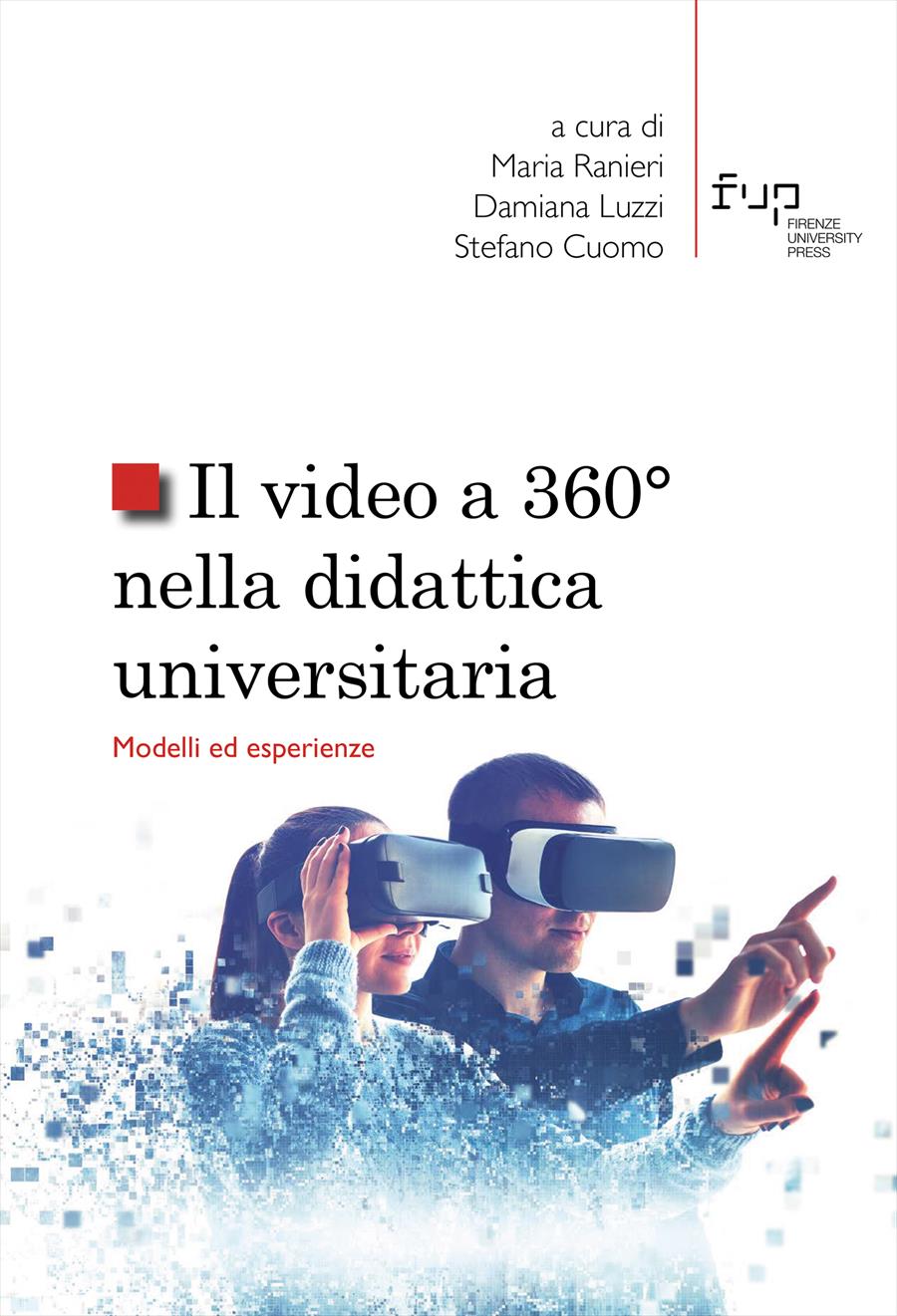- Il video a 360° nella didattica universitaria
- Edited by Maria Ranieri, Damiana Luzzi, Stefano Cuomo
Realizzazione di un video a 360°: dimensioni tecniche e operative
- Damiana Luzzi
- © 2022 Author(s) |
- CC BY 4.0
- DOI: 10.36253/978-88-5518-646-9.05
After a brief overview of some sectors where 360° video is used and which can benefit from its adoption, the chapter illustrates the technical aspects of 360 ° video, the equipment needed for shooting, the requirements and functionalities to choose the most suitable 360 ° camera, the shooting strategies, the delivery methods, the software for inserting interaction points, concepts such as immersion, presence and degrees of freedom, and the technical terms that must be known in order to easily move in the production of 360 ° video.
- Keywords:
- technical aspects and terms,
- 360° cameras and equipment,
- shooting strategies,
- delivery methods,
- interaction points,
University of Florence, Italy - ORCID: 0000-0002-8843-2072
- Ardisara, Alvita, e Fun M. Fung. 2018. “Integrating 360 Videos in an Undergraduate Chemistry Laboratory Course.” Journal of Chemical Education 95, 10: 1881-84. DOI: 10.14742/ajet.3671
- Cummings, James J., e Jeremy N. Bailenson. 2015. “How Immersive is Enough? A Meta- analysis of the Effect of Immersive Technology on User Presence.” Media Psychology 19: 272-309. DOI: 10.1080/15213269.2015.1015740
- Evens, Marie, Michaël Empsen, e Wouter Hustinx. 2022. “A Literature Review on 360-degree video as an Educational Tool: Towards Design Guidelines.” Journal of Computers in Education, 1-51. DOI: 10.1007/s40692-022-00233-z
- Gallegos, Jennifer, e Matt Spark. 2020. “360-degree Video: Composition, Location, Camera Placement.” Learning Solution Magazine, 23 January 2020. https:// learningsolutionsmag.com/articles/360-degree-video-composition-location- camera-placement
- García-Orosa, Berta, e Sara Pérez-Seijo. 2020. “The Use of 360° Video by International Humanitarian Aid Organizations to Spread Social Messages and Increase Engagement.” Voluntas 31: 1311-29. DOI: 10.1007/s11266-020-00280-z
- Milgram, Paul, e Fumio Kishimo. 1994. “A Taxonomy of Mixed Reality visual display.” IEICE Transactions on Information System, E77-D, 12: 1321-29.
- Mortesen, Dylan. 2017. “The Immersive Video Report: How VR, AR, and 360-degree Video Are Shaping the Future of Content Creation.” Business Insider, 24 febbraio 2017. https://www.businessinsider.com/the-immersive-video-report-how-vr-ar-and- 360-degree-video-are-shaping-the-future-of-content-creation-2017-2?r=US&IR=T.
- Pirker, Johanna, e Andreas Dengel. 2021. “The Potential of 360-degree Virtual Reality Videos and Real VR for Education. A Literature.” IEEE Computer Graphics and Applications 41, 4: 76-89. DOI: 10.1109/MCG.2021.3067999
- Ranieri, Maria, Damiana Luzzi, Stefano Cuomo, e Isabella Bruni. 2022. “If and How Do 360-degree Videos Fit Into Education Settings? Results From a Scoping Review of Empirical Research.” Journal of Computer Assisted Learning. DOI: 10.1111/jcal.12683
- Reyna, Jorge. 2018. “The Potential of 360-degree Videos for Teaching, Learning and Research.” In Rethinking Learning in a Connected Age. The 12th annual International Technology, Education and Development Conference, INTED2018 Proceedings, 1448- 54. DOI: 10.21125/inted.2018.0247
- Shadiev, Rustam, Yang Liuxin, e Yueh M. Huang. 2021. “A Review of Research on 360-degree Video and its Applications to Education.” Journal of Research on Technology in Education. DOI: 10.1080/15391523.2021.1928572
- Slater, Mel, e Sylvia Wilbur. 1997. “A Framework for Immersive Virtual Environment (FIVE): Speculation on the Role of Presence in Virtual Environments.” Presence: Teleoperators and Virtual Environments 6, 6: 603-16. DOI: 10.1162/ pres.1997.6.6.603
- Witmer, Bob G., e Michael J. Singer. 1998. “Measuring Presence in Virtual Environments: A Presence Questionnaire.” Presence: Teleoperators and Virtual Environments 7, 3: 225-40. DOI: 10.1162/105474698565686
- Yuen, Steve Chi-Yin, Gallayanee Yaoyuneyong, e Eric Johnson. 2013. “Augmented Reality and Education: Applications and Potentials.” In Reshaping Learning. New Frontiers of Educational Research, Springer, Berlin, Heidelberg, a cura di Ronghuai Huang, Ryan Jesse Kinshuk, e Michael J. Spector, 385-414. DOI: 10.1007/978-3-642-32301-0
Chapter Information
Chapter Title
Realizzazione di un video a 360°: dimensioni tecniche e operative
Authors
Damiana Luzzi
Language
Italian
DOI
10.36253/978-88-5518-646-9.05
Peer Reviewed
Publication Year
2022
Copyright Information
© 2022 Author(s)
Content License
Metadata License
Bibliographic Information
Book Title
Il video a 360° nella didattica universitaria
Book Subtitle
Modelli ed esperienze
Editors
Maria Ranieri, Damiana Luzzi, Stefano Cuomo
Peer Reviewed
Number of Pages
164
Publication Year
2022
Copyright Information
© 2022 Author(s)
Content License
Metadata License
Publisher Name
Firenze University Press
DOI
10.36253/978-88-5518-646-9
ISBN Print
978-88-5518-645-2
eISBN (pdf)
978-88-5518-646-9
Series Title
Studi e saggi
Series ISSN
2704-6478
Series E-ISSN
2704-5919
